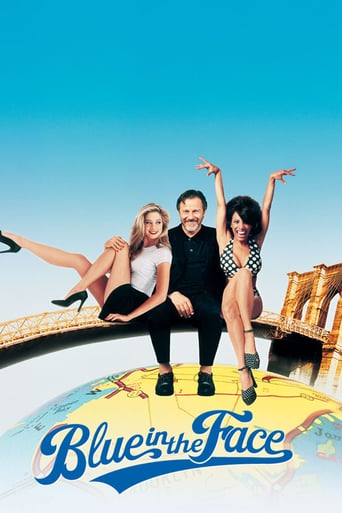Syl
Brooklyn, New York has changed over the last 18 years since this film first premiered. The location near Prospect Park is now one of the most desirable locales to live and reside in the borough and even in New York City. Brooklyn's transformation from a working class borough has changed in some parts. Brooklyn has become hip for the trend setters. It also gentrified in areas especially near the Prospect Park, Brooklyn's Central Park. Still, the film reminds me of another time when Brooklyn wasn't so hip or trendy but real. The people of Brooklyn and New York City like Harvey Keitel, Lou Reed, and others recall their likes and dislikes as well. They spend their time smoking at the Brooklyn Cigar Shop where Augie played by Keitel is the manager but not the owner. The cast includes top notch performers like Lily Tomlin, Lou Reed, Roseanne, Mira Sorvino, etc. A lot of the film's script seems improvised but it makes the film more authentic to documenting the life in a day.
Cristi_Ciopron
I have founded this semi—documentary about the Brooklynian way of life from an ordinary man's POV rather amusing and compelling—and very sarcastic and mordant; it's studded with vaguely familiar faces (whose identities are mostly unknown to me, as I am not a frequenter of the culture in cause—the Jarmusch/ Madonna brands …). The movie is, as I suggested, ironic—yet _unconclusively so. It is unassuming, sometimes funny, and Mel Gorham is very sexy. On the other hand, it's not too intense or particularly successful at seizing the hidden life of Brooklyn. It has the intelligent, not really intellectual or particularly inspired look of other similar attempts—like some Mamet outings …. It's not insightful or meaningful—but funny, light, enjoyable. It is also cruel and merciless in exposing empty lives—people to whom the Dodgers' leaving was the most important thing in their lives, etc., insipid, lifeless existences, withered humanity, banal destines soaked in ugliness. This world is wholly alien to me. This Auster intellectuality, like some Mamet mean intellectuality, seems not very far from the W. Allen intellectuality.I guess the film is for the most part ironic; yet if it was meant to convey a certain savor of Brooklyn life, it did not succeed—at least with those ignorant of Brooklyn things. The Dodgers and the Belgian waffles are part of that Americana (what Amis once stated as 'too much trolley-car nostalgia and baseball-mitt Americana, too much ancestor worship, too much piety ') that is particularly unattractive to me. In this sociological sense ,the movie describes an utterly uninteresting world and humanity. These things do not seem to me childish—but, on the contrary, senile and boring. These ingredients are particularly repulsive to me. What strikes is the artificiality and shallowness and inner poverty of these clichés. Some 60 years ago, some Europeans, many French Europeans hinted this might denote a style—and even be a stylish thing. Maybe they meant different realities, or maybe things changed too much.
Mikew3001
"Blue in the Face" was a fastly produced follow-up of director Wayne Wang's and writer Paul Auster's 1994 art house hit "Smoke". While "Smoke" was produced in the usual way with script, casts, etc., this movie was a quickly shot within less than a month, just containing vague ideas, interviews and improvisations with the same production unit and main actor Harvey Keitel, but without a script and with lots of popular supporting actors who were improvising their performance straight in front of the camera. And it works.Focused on Keitel's smoke shop in Brooklyn, his customers and visitors are telling stories about their lives, views, ideas, dream, relationships and carreers, all focused around the topic of smoking. Lou Reed can't remember his first cigarette, but presents his self-constructed glasses, Jim Jarmusch celebrates his last cigarette, Harvey Keitel reminds which war movie made him a cigarette smoker, and there are several more famous guests in the shop. Michael J. Fox plays a weird insurance guy, Madonna appears as a singing telegram girl, and John Lurie, Mia Sorvino, Paul Keith and the whole NYC artist's scene appear on the screen.Although the pointless composition of independent scenes and interviews might become a bit out of tune or boring sometimes, the movie works really well. There are lots of interesting (real life?) stories told by the actors, a great rare groove soundtrack that could fit into every Tarantino production, and some really good jokes too. "Blue in the Face" become a minor art house classic in Europe in the nineties, and one could wonder if this movie would have been the same ten years later in the times of anti-smoking laws and campaigns. Nice independent movie.
Mr Pants
This is a great little set piece to celebrate the diversity and chaos that is, among many other things, my home. Brooklyn is the main character of this story and despite the film's limited scope (set mostly around a tobacco store near Windsor Terrace), it manages to really get at that feeling that makes Brooklyn the only place I wanna live. All the people here, whether they're bored by Brooklyn or fascinated by it, are connected by the genuinely weird way we manage to live together, despite our very prominent differences.



